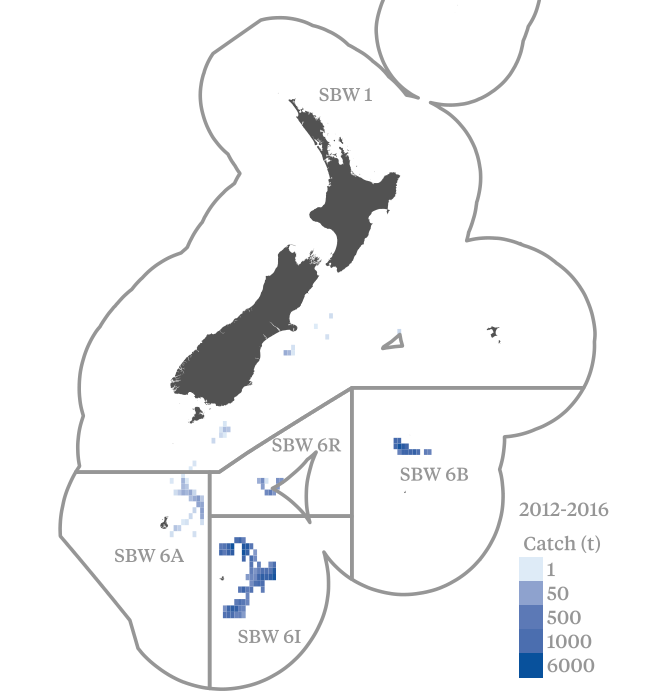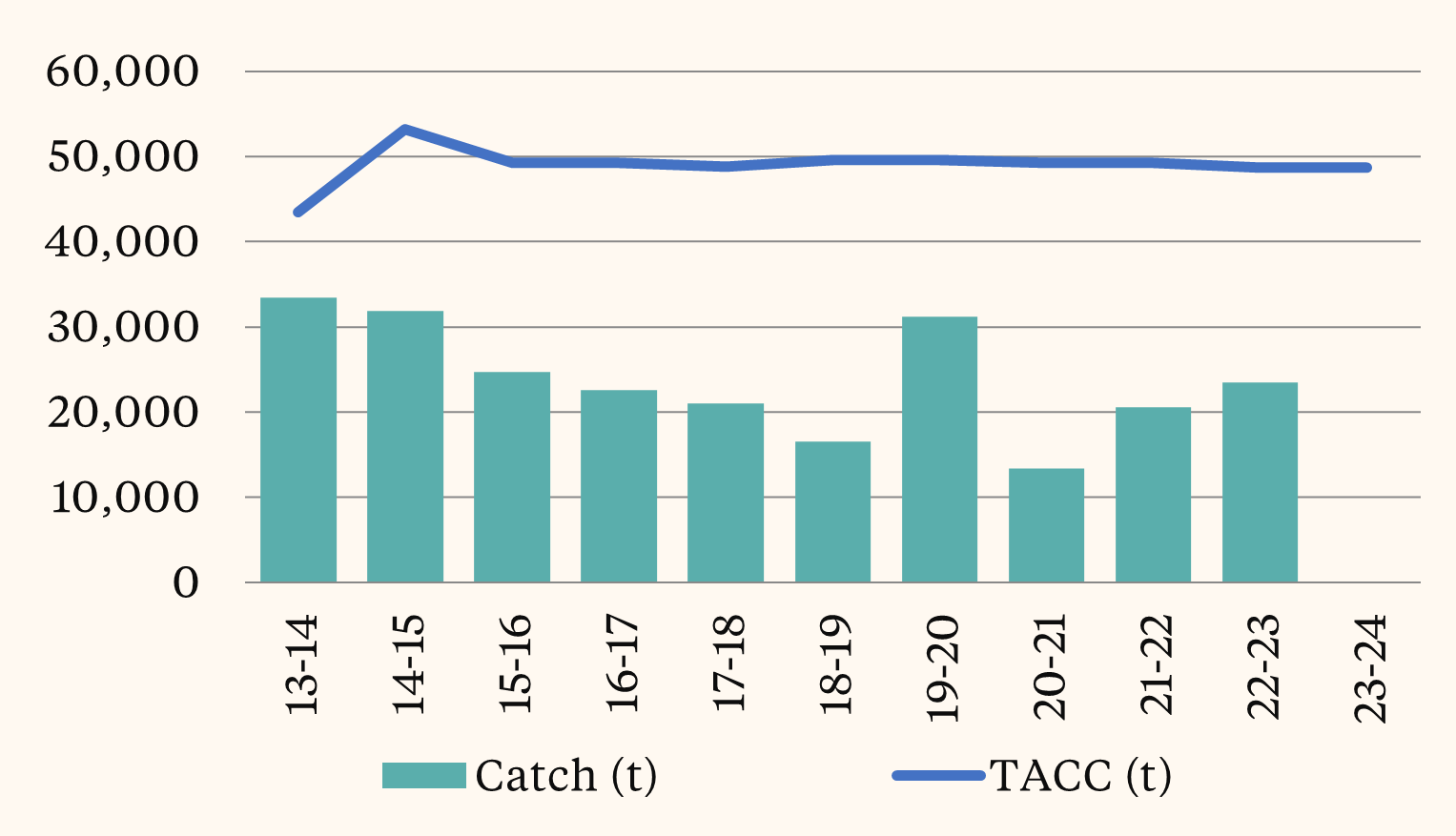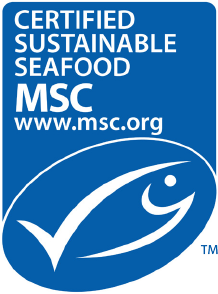Southern Poutassou
The New Zealand southern blue whiting trawl fishery is a well managed and sustainable fishery in accordance with the Marine Stewardship Council's Principles and Criteria for Sustainable Fishing.
Southern blue whiting are harvested almost entirely by mid-water and semi-pelagic trawl and are generally found in sub-Antarctic waters. They are mostly harvested at depths of 250 m to 600 m, with the main fishing grounds to the south of New Zealand.
Southern blue whiting are managed as separate biological stocks based on their spawning areas: Campbell Island (SBW 6I), Pukaki Rise (SBW 6R), Bounty Platform (SBW 6B) and Auckland Islands Shelf (SBW 6A).
Southern blue whiting are managed by Fisheries New Zealand using the Quota Management System (QMS). The Ministry works in partnership with Seafood New Zealand | Deepwater Council (a not-for-profit organisation that works on behalf of fisheries quota owners). The two parties have developed a single joint-management framework with agreed strategic and operational priorities and work plans. The partnership is focused on determining the maximum economic yield of the deepwater fisheries by setting catch limits that maximise returns over the long term within the constraints of ecological sustainability.
The MSC Certification covers about 97% of all southern blue whiting caught in New Zealand. Southern blue whiting was re-certified in 2018.
For more information, download the full MSC Certification Report.
The MSC scheme follows international benchmarks to promote robust processes and uphold values of independence, transparency, impartiality and stakeholder consultation.
The MSC assessment process is run by an independent certification body (accredited by Accreditation Services International GmbH). A group of auditors (with expertise in the fishery and ecosystems under consideration) are responsible for scoring the performance of the fishery based on scientific evidence. Auditors must meet the qualifications and competencies set out in the MSC Certification Requirements.
In order to achieve MSC certification, a fishery must pass 28 performance indicators within three core principles: sustainable stocks, minimising environmental impact and effective management.
The certification process takes between 6 and 18 months. The assessment process includes opportunities for stakeholder input and peer review. Certification lasts up to 5 years, during which time the fishery makes any improvements required as a condition of certification. Annual audits are carried out by the certifier to ensure continued compliance. A full reassessment of the fishery must be completed within five years of the last certificate being granted.
The information presented on this page is extracted from the MSC Public Certification Report and most recent Surveillance Audit Report. More information can be found at www.msc.org


Assessment Summary

Sustainable target fish stocks
Principle 1 states a fishery must be conducted in a manner that does not lead to over-fishing or depletion of the exploited populations and, for those populations that are depleted, the fishery must be conducted in a manner that demonstrably leads to their recovery.
All southern blue whiting stocks are at a level that maintains high productivity and has a low probability of overfishing. The report of the Stock Assessment Plenary (and individual stock assessment reports) summarises information on stock structure and biology of southern blue whiting.
Environmental impact of fishing
Principle 2 states that fishing operations should allow for the maintenance of the structure, productivity, function, and diversity of the ecosystem (including habitat and associated dependent and ecologically related species) on which the fishery depends.
A management strategy is in place for the southern blue whiting fishery that is highly likely to achieve national and international requirements for the protection of endangered, threatened, and protected (ETP) species. For the southern blue whiting fisheries, interactions focus on seabirds, marine mammals, and cold-water corals.
Key interactions appear to be with sea lions and fur seals, and a recent risk-based analysis placed seals and sea lions within the higher end of the medium risk category with respect to trawl fisheries (noting that this included the squid trawl fishery and was across the New Zealand EEZ). Given that fur seal numbers are widely considered to be increasing, the fishery interaction rate appears highly unlikely to affect the population.
The southern blue whiting trawl fishery is not thought by experts to represent an especially high risk for seabird populations, as long as effective management measures, including mitigation, are in place. By law, trawlers over 28 m in length fishing in New Zealand waters are required to use one of three specified devices to reduce seabird interactions with trawl warps; paired streamer lines, a bird baffler or a warp scarer.
Studies are ongoing to identify the distribution and potential interaction rates of the fishery with protected cold-water coral species. Recent analyses of observer records suggested near-zero interactions with main coral groups. While the observer records do not provide complete coverage of the fishery, the infrequent encounters of ETP species in the available data, combined with the fishery footprint and semi-pelagic fishing method, suggest that it is highly unlikely that trawl fishing for southern blue whiting will create unacceptable impacts.
Effective management
Principle 3 requires that a fishery is subject to an effective management system that respects local, national, and international laws and standards and incorporates institutional and operational frameworks that require the use of the resource to be responsible and sustainable.
The southern blue whiting management system has an effective monitoring, control and surveillance system, including satellite vessel monitoring systems, government observers, and accurate reporting and record-keeping. Sanctions to deal with non-compliance in the fishery exist, and are consistently applied. However, the preferred approach is to work collaboratively with industry to prevent non-compliance.
The National Fisheries Plan for Deepwater has specific objectives for southern blue whiting that directly guide actions in the fishery. These are specified in the Annual Operating Plan and progress reported in the Annual Review Report.
The southern blue whiting fishery has been managed within the Quota Management System since its inception in 1986.
Summary of assessment conditions
There are no conditions.

